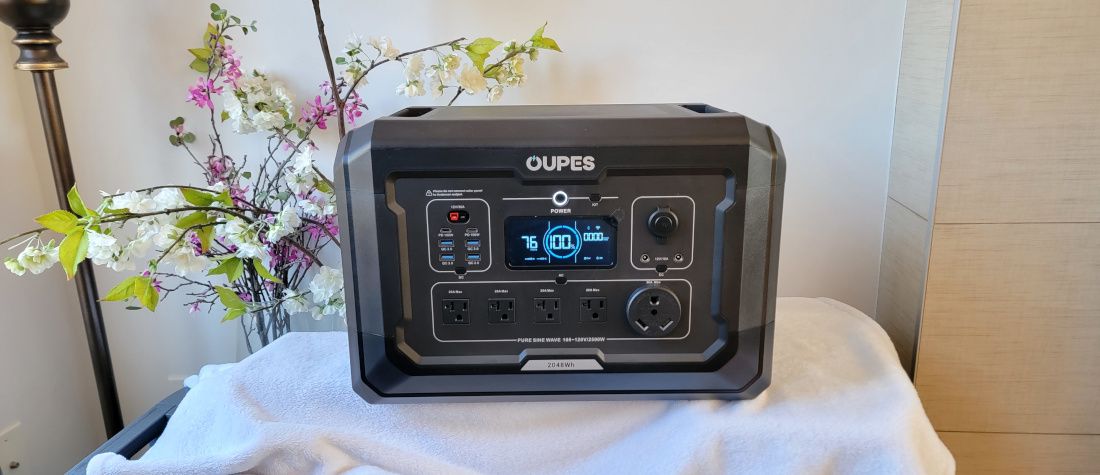Oupes’ new Mega 2 portable power station, with a 2048Wh battery capacity and 2500W AC power inverter, brings affordable rechargeable power to the masses.
Specifications
Battery chemistry: LiFePo4
Battery capacity: 2048Wh
Number of charge cycles: Over 3500 before 20% drop
AC output power: 2500W, surge 5400W
Number of AC outlets: 4
Number of USB sockets: 4 Type A, 2 Type C
Number of 12V sockets: 1 Anderson, 1 Cigar lighter, 2 DC 5521
AC inverter efficiency: 86%
Number of power inputs: 2
Fastest charge time: 1 hour
Additional features: Bluetooth and Wi-Fi connectivity
Weight: 22kg
Based on the proven LiFePo4 Lithium chemistry, the station will provide over 3500 charge cycles before experiencing a 20% drop in battery capacity. The design allows for future battery expansion, enabling up to two additional power packs for a total capacity of over 10kWh.
The unit can fast charge at 1600W, resulting in a full charge in less than two hours. Charging through solar panels yields an even higher rate at 2100W. The Mega 2 has fifteen low-power outputs to accommodate many home uses, and a TT30 socket is an excellent addition for road trips. A snappy mobile app available for Apple and Android allows complete control of the unit while providing helpful insight into output power consumption and the overall health of the station.
Oupes Mega 2: Pricing and Availability
Oupes Mega 2: Pricing and Availability
Oupes’ Mega 2 has an MSRP of $1500 and is available at a special price of $1039 for a limited time, about 2WHr per dollar. Oupes also offers other stations with smaller and larger power capacities. The Mega 3 and 5 offer 3000Wh and 5000Wh, respectively, although they cost more, at $2240 and $3500. The Mega 1, the smallest in the family, offers only a 1kWh battery for $700.
Oupes Mega 2: Design
The Mega 2 ships with four Anderson cables, allowing the station to be used on the road or with solar panels, one AC charging cable, and a user manual. It measures 46cm x 27cm x 31cm and weighs 22kg. The plastic case has two handles on each side, allowing the unit to be moved rapidly from one place to another. Two large fans on the left bring decent airflow to the battery charger and AC inverter.
The Oupes Mega 2 has a powerful battery charger that supports up to 2100W through the solar DC input. With a maximum voltage of 150V, the unit can connect to ten 200W 12V panels, completing a charge cycle in less than two hours. The same input is used to charge the battery with the supplied car cable, but it will take much longer since the power is limited to 100W.
Like other power stations, the front panel hosts a large display and buttons to control the outputs. The LCD is bright and shows the percentage of the battery remaining. Input and output power are also shown but in smaller characters. Protections when the output power exceeds the maximum allowed also appear on the display.
The Mega 2 offers plenty of output options to the user. The low-voltage DC sockets include 12V outputs and the ubiquitous USB Type-A and Type-C. Both USB sockets support quick charge through a higher power profile. The Type-C can output a maximum of 100W, while the Type-A can only output 18W. Two 12V high-power outputs are also available, one supporting an Anderson connector that can output 360W, while the other is a cigar plug capable of 120W.
Oupes Mega 2:
Oupes Mega 2: In Use
The AC output is more than capable of powering even the most demanding of household appliances. Rated at 2500W with short bursts of 5400W, the Mega 2 can give 120V at 1500W off four regular AC sockets. A fifth socket provides 2500W of power in a TT30 format, which is convenient on road trips to power a trailer’s main electrical outlets.
Oupes has been generous with the charging options available in the Mega 2. Surprisingly, with its 1600W input power, the AC input is not the fastest way. The Anderson DC input supports 2100W and, with appropriate solar panels, can recharge the batteries in less than one hour. The DC input tolerates up to 150V, conveniently accepting ten 12V solar panels in series. The Mega 2 has an extra DC port, which can take an additional 2kWh battery.
Oupes’ mobile app replicates the power station’s display functionality. The app initially pairs with a smartphone over Bluetooth and requires entering a QR code. The Mega 2 also includes a Wi-Fi interface, eventually becoming the main communication channel once the Bluetooth step is over. This means user data are transferred to Oupes’ cloud services, and the power station becomes accessible worldwide.
The Mega 2 features several protection mechanisms to prevent battery failures and damage to the station or connected equipment. Over ten error codes can be displayed on the front screen, each with a clear description in the user manual. As with any device that generates a lot of heat, it is recommended that the Mega 2 be kept in a well-ventilated area. With an efficiency of 86%, the unit is in the ballpark for this class of power stations.
Oupes Mega 2: The competition
Oupes’ Mega 2 falls into the medium-sized power station with combined output power, AC, and DC, approaching 3kW. The 2kWh LiFePo4 battery brings it to the same level as the Bluetti and Ecoflow flagships. The volume taken by the station is about 26L, a smaller amount compared to the Mega 2’s two main competitors. Similar products have fast charging capabilities, which the Mega 2 excels at with its 2100W DC charge.
The Bluetti AC200L has battery capacity and output power similar to the Mega 2. The Bluetti and Ecoflow brands carry an MSRP higher than an Oupes station since they were the first to use LiFePo4 and have an established brand. Compared to the AC200L, the Mega 2 is also 25% smaller and weighs 22kg compared to the AC200L’s 28kg.
Oupes Mega 2: Final verdict
The Mega 2 power station from Oupes offers solid competition to Ecoflow and Bluetti products in terms of output power and battery capacity. Being a cheaper solution with similar battery technology, the Mega 2 is a more compact and lighter unit that packs as many, if not more, power outlets. It offers a battery expansion that can reach 10 kWh and is remotely controlled through a mobile app. What is missing is the brand recognition and community support the more well-known brands enjoy.
We list the best rugged phones.
Read the full article here














